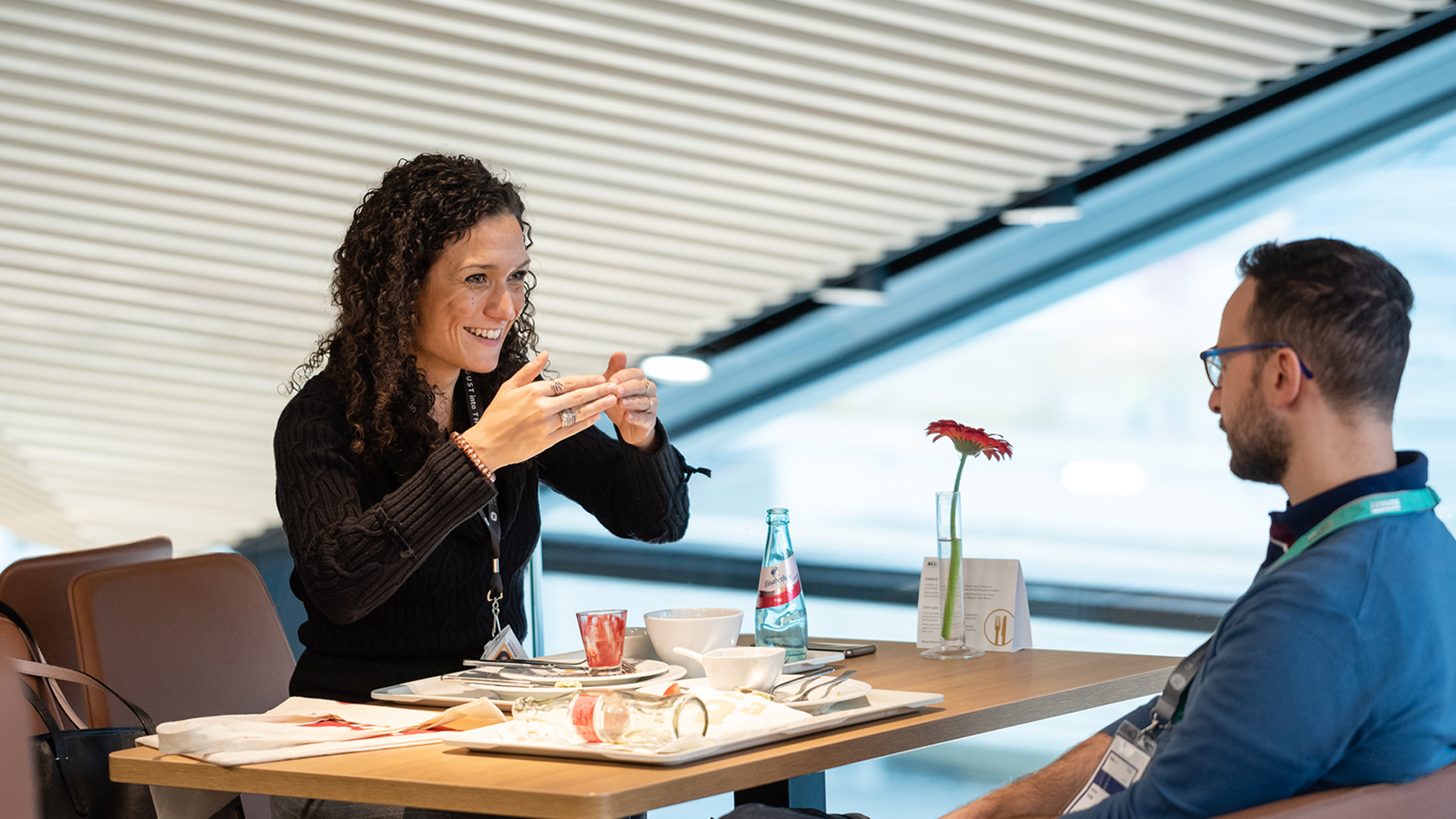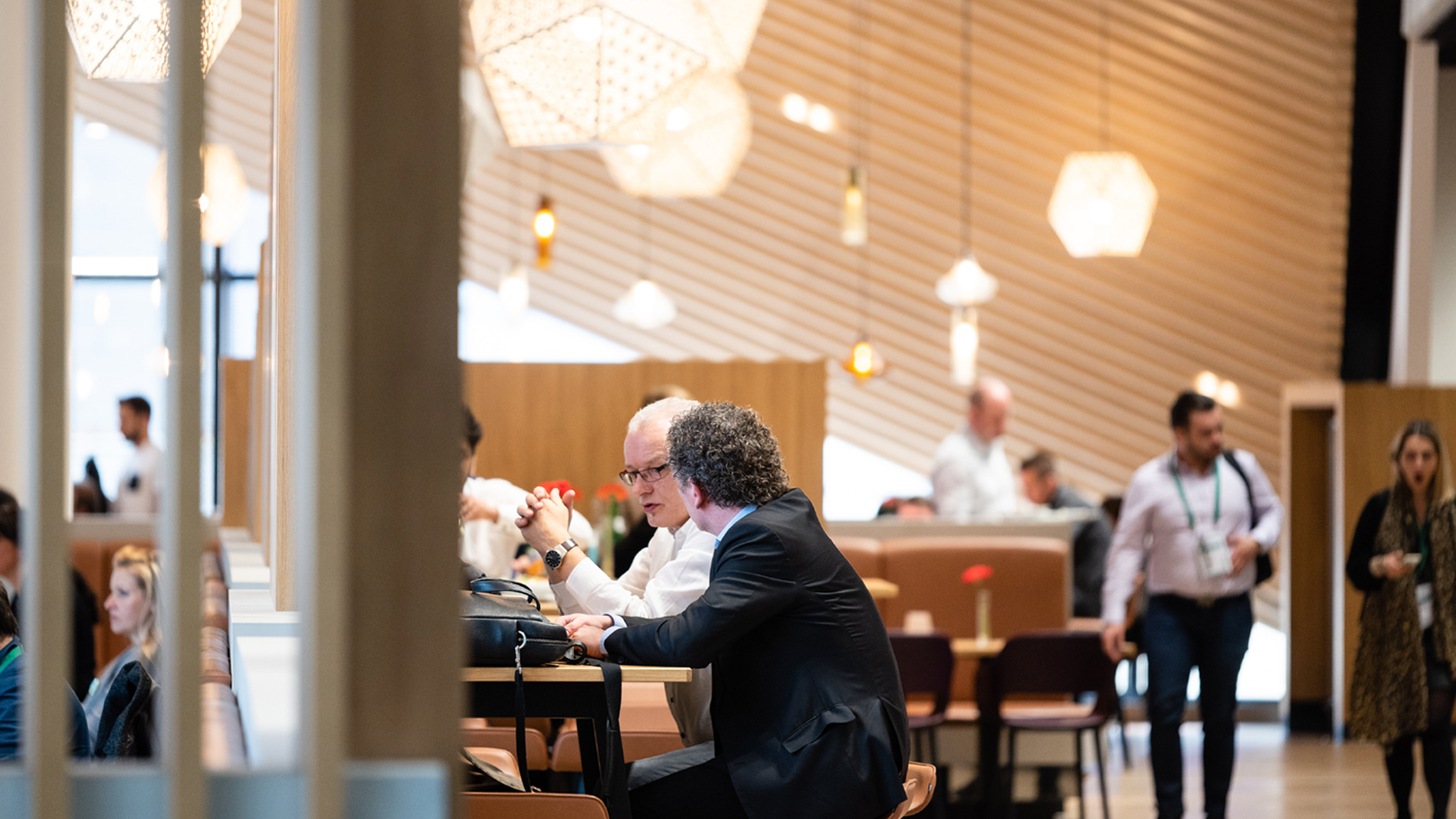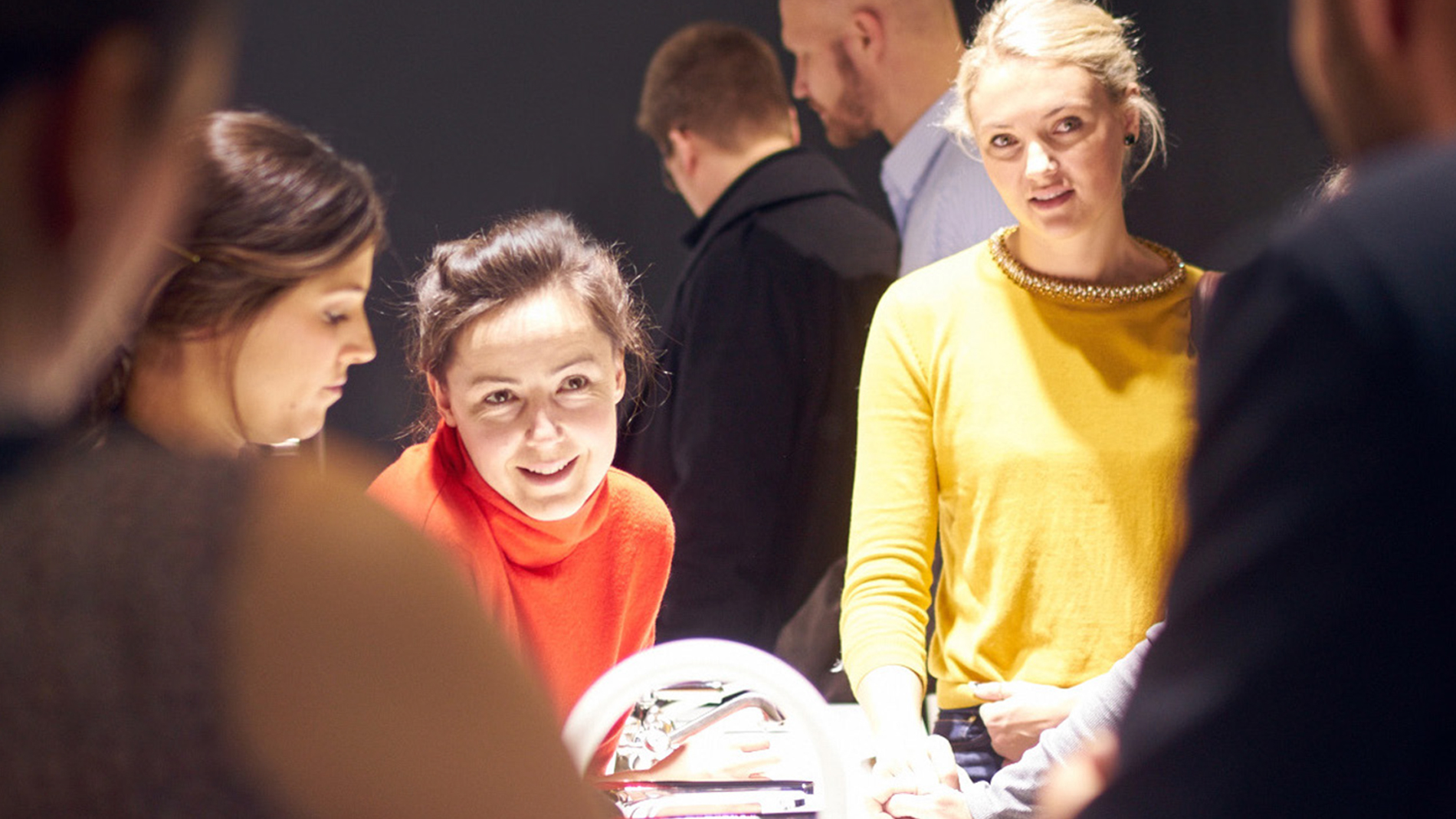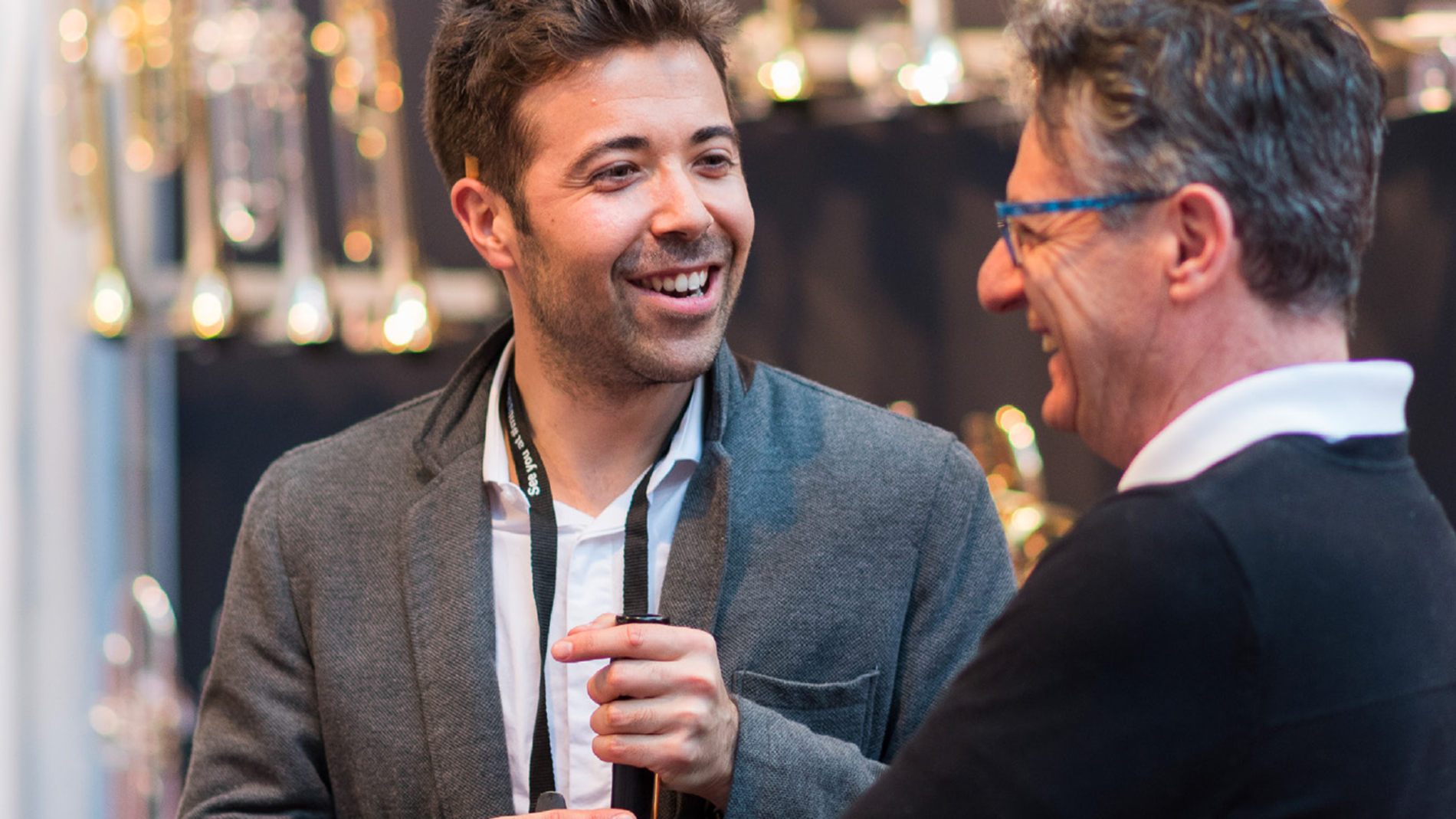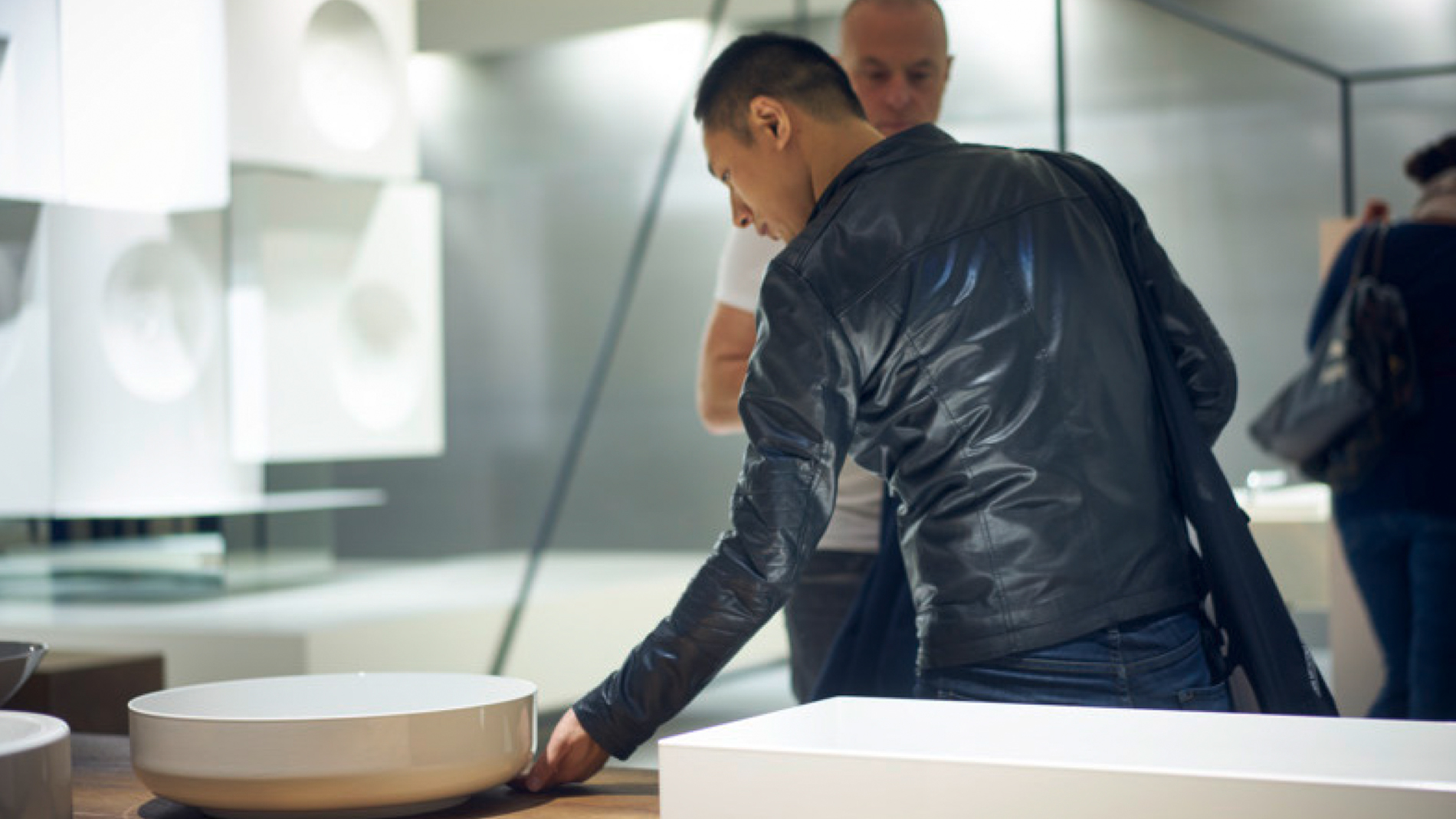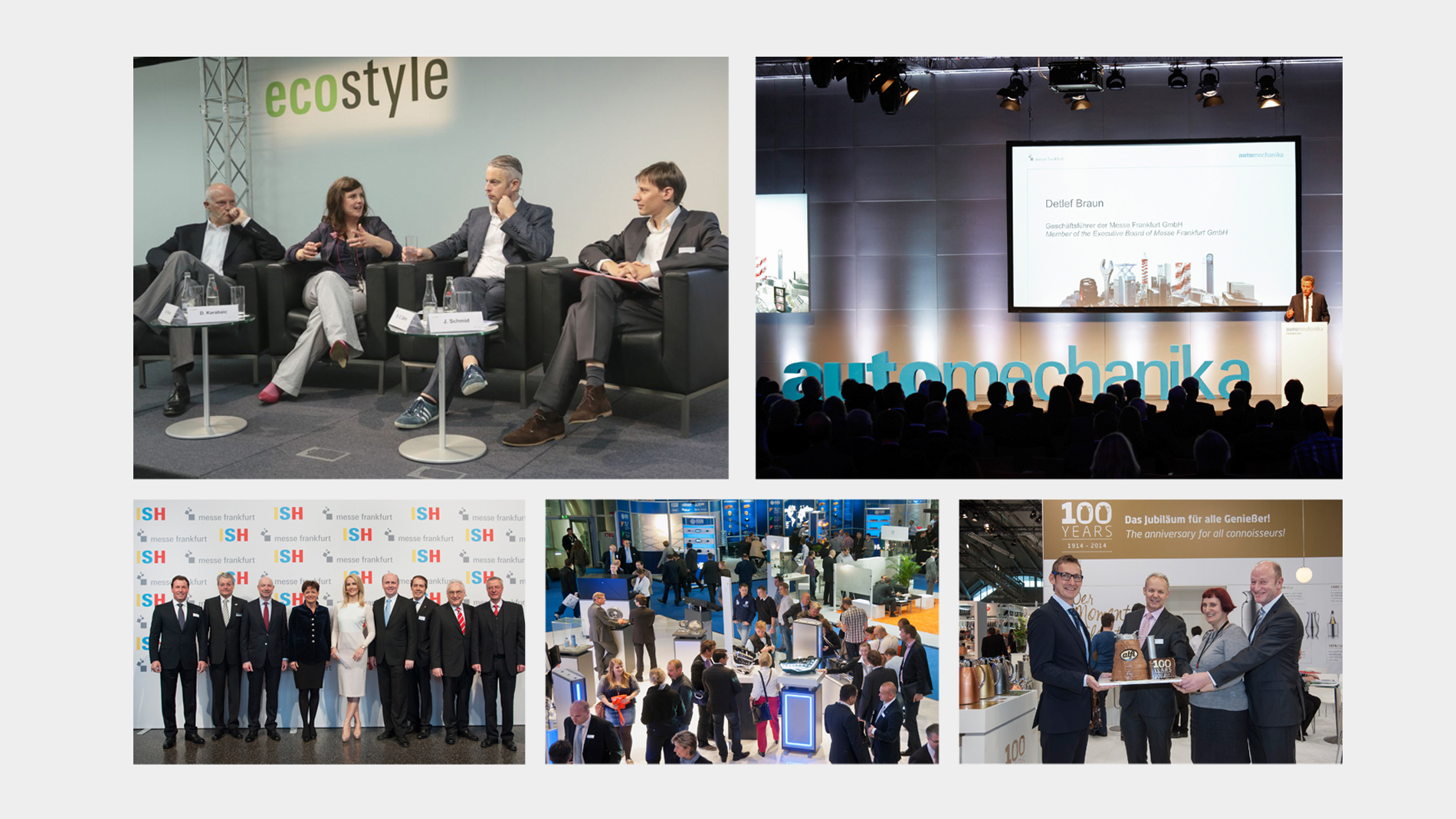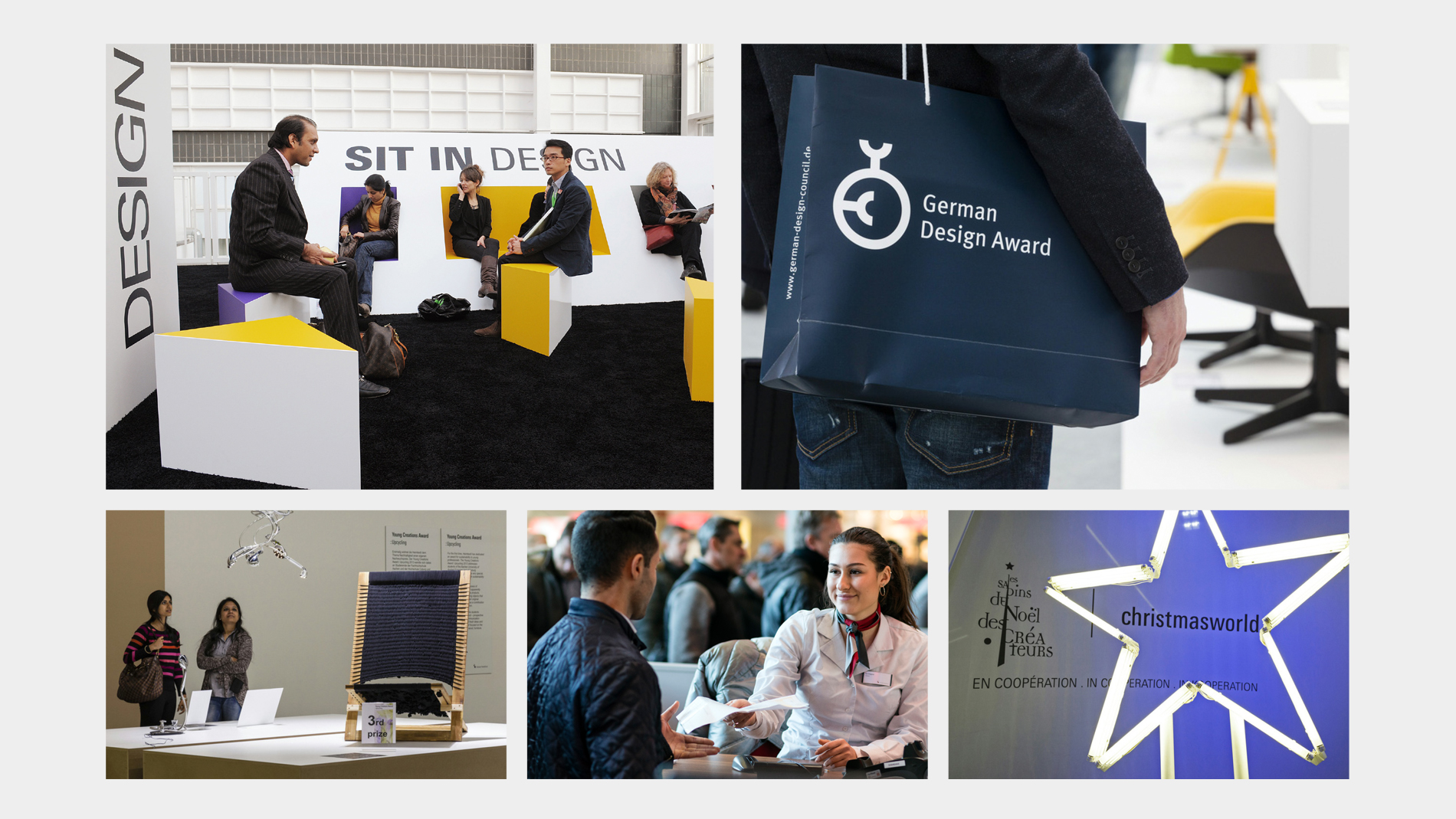Promotional imagery style
Photos serve to illustrate text and convey emotions much faster and more directly than any word could. Because they support the written message in this way, they are a central component of all forms of communication – whether promotional or documentary. A high-quality photo with a clear message ensures that the target group is optimally addressed.
When creating and selecting these photos, the theme of personal encounters, as described in the brand story, is of central importance. Here, formal aspects such as perspective (eye level), distance (calling distance), focus (play with sharpness and blur) play an important role and give the viewer the feeling of being right in the middle of the action.
Person – Architecture
Architecture as the framework for personal encounters. The unique architecture of Messe Frankfurt designed by renowned architects is not the main focus, however – it has the clear purpose of being both the ideal space for our customers to showcase their brands and the optimal setting for profitable personal encounters.
Focus: personal encounters in a recognisable space.
Dos
- Context: recognisable architecture of Messe Frankfurt as a framework for personal encounters (greeting, conversation, celebration)
- Architectural details in the background underscore the high recognition value of the exhibition grounds
- Camera: eye level, show people interacting with architecture
- Atmosphere: natural lighting, preferably daylight
Don’ts
- Pure staging of architecture, extreme perspectives, overstaged situations, architecture without people
Person – Person
The moment when two or more people meet personally. The magic of the moment when they “hit it off”. The moment when people discover common ground, initiate or conclude a deal, exchange ideas and the pleasure of doing so is plain to see.
The moment when orientation, help, understanding or simply a smile is offered. Focus: the moment of encounter
Dos
- Context: natural situations, proximity, viewer is part of events
- Camera distance: calling distance
- Perspective: at eye level
- Atmosphere: foreground out of focus, natural lighting
Don’ts
- Bird’s- or worm’s-eye view, blurred movements, overstaged situations, people photographed from behind
Person – Product
The moment when people explore, experience, test products together and exchange views.
The magic of the moment when, despite the hustle and bustle of the trade fair, people, while looking at a product, block out everything around them or explore a product together and enter into a dialogue about it – touching materials and shapes, assessing proportions and testing functions. Focus: interaction as an encounter.
Dos
- Context: natural situations, proximity, products in a spatial context, cut-outs/product details, interaction between person and product
- Camera distance: calling distance
- Perspective: at eye level
- Atmosphere: foreground out of focus, natural lighting, staging from different angles
Don’ts
- Extreme perspectives, blurred movements, overstaged situations, people photographed from behind
Press photography
Press photography primarily has a documentary character and a high informational or news value. Press photography is about capturing brief moments and snapshots of events and it should have the quality to optimally transport the key message. Focus: documenting encounters.
Dos
- Context: people should interact and face the camera, occasion/surroundings should also be depicted
- Camera: eye level, as close as possible
Don’ts
- Extreme angles, worm’s-eye view
Themes
The theme worlds of an event are staged from a promotional perspective, presented in a clustered manner and thus made tangible. Photos of interactive product demonstrations, special exhibition areas or visitors interacting or looking at exhibited items can thematically illustrate these theme worlds. Focus: encounters within theme worlds.
Dos
- Context: people are shown in front of graphics/lettering/media/giveaways relating to the respective theme world, detail shots of staged graphical elements illustrate the individual presentation of the themes
- Camera: eye level, proximity, unusual angles
- Atmosphere: side shots of larger audience or groups of people together with the speaker so that the majority of faces can be seen
Don’ts
- Do not photograph the audience from behind (too many rear views).
Portraits
Individual and group portraits show individual characters of exhibition staff, visitors and exhibitors. Portraits can be sensitively staged, personal details create atmosphere and arouse sympathies. They can intensify customer relationships and strengthen loyalty towards the Messe Frankfurt brand, and can also develop a high appeal within the company. Focus: encounters with individual characters.
Dos
- Context: photos should emphasise a personal feel, may also show serious, concentrated faces focused on the matter in hand
- Camera: eye level, proximity, out-of-focus effects in order to make an individual stand out from the crowd
- People do not necessarily have to be photographed from the front; side shots in semi- or three-quarter profile as well as movements are equally welcome.
- Atmosphere: the defined backdrop can create/emphasise the personal context and help to tell the story of the person photographed.
Don’ts
- Shots that appear “wooden”, static postures
Press portraits
Press portraits with symbol are used singly or in series in digital and analogue media and show Messe Frankfurt staff in typical architectural settings.
Messe Frankfurt staff are depicted on mf.com in front of a neutral grey background. Focus: encounters with Messe Frankfurt employees.
Dos
- Press portraits are taken in the walkway between Halls 4 and 3. The symbol is permanently installed on a pillar forming part of the window façade.
- Press portraits for Mesago, or where it is not possible to shoot on location, are taken against a grey/neutral background and composited.
- As a basic principle, on shootings portraits against a neutral background are also needed, so that they can be used flexibly. Therefore, during the photo shoot you should make sure the (natural) light comes from the left.
- Subjects should adopt a similar head and body posture and should not be presented from a too open / head-on or too closed perspective. They should be the same head size.
- All portraits should replicate the lighting situation in the area of the pillars – also against a neutral background.
- Recommended clothing: plain-colour suit/jacket, plain-colour shirt/blouse, plain tie
- Camera: eye level (when shooting in front of the pillar pay attention to the position of the logotype – shorter people should be slightly elevated)
Don’ts
- Other backgrounds
- Clothing: patterns or shiny fabrics
AI in visual communication
Artificial Intelligence (AI) has become a natural part of our professional lives.
It helps us achieve results more quickly, with greater precision and often at lower cost. Messe Frankfurt, with its strong and recognisable brands, makes wide use of visual content in marketing and corporate communications. Usually, this content comes from recent photographs or real video material produced specifically for these purposes.
AI can be a meaningful addition where a certain image or video would be difficult or prohibitively expensive to create in the conventional way. Since the legal framework for using AI-generated content is continuously evolving, this guideline offers orientation. It serves to:
- uphold ethical standards
- protect the integrity of our brands and strengthen trust in our brand – both internally and externally
1. Principles for the use of AI-generated images
- Personal encounters between people are at the heart of our brand – they represent our brand essence (“We celebrate personal encounters”).
- Real moments and genuine faces therefore take priority, especially in external communications.
- The content-related and formal criteria of our visual language apply regardless of how an image is created – including AI-generated content.
- AI may be used where it adds creative or functional value, without undermining authenticity or credibility, and without being misleading.
2. Permitted uses from a brand perspective
Allowed when used for abstract or general topics such as idea generation, mood images or conceptual sketches – for example, in the early stages of development, planning or proposal phases, where the draft character remains visible.
- marketing, press or social media images show no people, or
- people are depicted in a stylised, illustrative or clearly artistic way.
- the image does not simulate a real location, actual event or specific situation that does not/did not exist,
- the image does not show products that could be misunderstood as real offers from our company (if such products do not exist),
- stylised depictions of fictional or exemplary products (e.g. in key visuals for trade fairs) are recognisable as such and do not give the impression of a real offer
3. Not permitted
- Use of AI-generated content featuring photorealistic people in external communications such as press/PR, marketing, websites or social media.
- AI-generated content that recreates or fabricates real situations, events or testimonials that never took place.
- Use of AI content that does not match our brand image in style, content or quality (see visual identity).
- Depiction of fictional products, services or solutions that do not exist in reality but could be misinterpreted as actual offers from our company.
- Depiction of locations, buildings or scenarios that appear realistic but do not exist, thereby presenting a distorted image of our company.
- AI-generated content based on real people is prohibited, as this infringes personal rights and may have legal consequences.
4. AI-assisted alterations of image and video material
AI-assisted modifications of real content used externally are only permitted if they:
- verantwortungsvoll eingesetzt werden und keine irreführenden Eindrücke erzeugen,
- are applied responsibly and do not create misleading impressions,
- do not falsify the original message, especially concerning depicted products, locations or events,
- only affect non-human details,
- do not make deep or manipulative changes to real people (e.g. face replacement, change of mood),
- do not create the impression of a real situation that never actually happened.
Permitted are:
- stylistic adjustments (e.g. colour correction, light adjustment, background blur, etc.),
- compositional additions in detail, as long as they do not create a misleading impression (e.g. an AI-generated plant in a neutral background).
Note: This page provides brand-related guidance and does not replace legal advice. Content is updated regularly.
Dos
- AI-generated illustration of an abstract key visual for a trade fair
- AI rendering of a concept product (e.g. stylised technology) for a trend theme
- Use of stylised AI-people in a futuristic scenario (e.g. on an internal innovation slide)
- AI-generated background image for internal presentations (e.g. colourful patterns, light moods)
- AI image with a clearly conceptual style used as a visual mood board
- AI 3D-rendered illustration for an initial idea of an exhibition stand
Dont‘s
- AI-generated photorealistic image of an exhibition stand with a fictional exhibitor
- Depiction of catering products that do not exist, shown as real offers
- AI-generated group photo for the team page of a website
- AI image of a realistic-looking conference room that does not exist
- AI-generated image with religious, cultural or political symbols without context
- AI-generated photorealistic trade fair stand placed into a press image of an event
